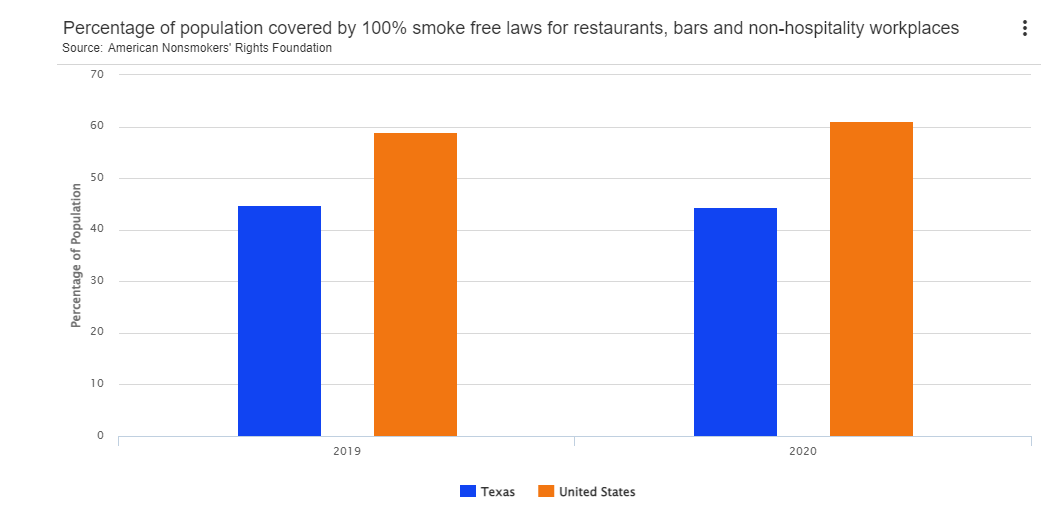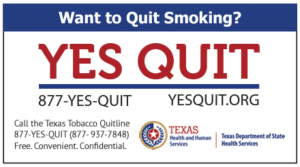Tobacco Use in Texas



Tobacco Cessation Resources:
- UT Austin Tobacco Research & Evaluation Team ETP Project one pager
- eTobacco Palmcard
- Texas Quitline App Card
- Tobacco Cessation Self-Instructional Webinar
The UT Tobacco Research & Evaluation Team provides support to healthcare systems for the implementation of tobacco cessation support strategies, by referring patients who use tobacco and wish to quit, to the Texas Quitline. Referrals can be made by fax, app or through the electronic medical record using the eTobacco Protocol (electronic tobacco cessation referral protocol). When a patient is referred to the Quitline by a healthcare professional, the patient can receive up to 5 counseling sessions and approximately 2 weeks of nicotine replacement therapy if they are 18 or older.
The Center for Disease Control and Prevention (CDC) reports that tobacco remains the leading preventable cause of death and disease in the United States and kills over 80,000 people each year.
The Center for Disease Control and Prevention (CDC) reports that tobacco remains the leading preventable cause of death and disease in the United States and kills over 80,000 people each year.

Texas has a lower smoking rate than the United States as a whole. In 2019, 13.2% of Texans smoked compared to 15.5% of Americans. However, as cigarette use has decreased, e-cigarette use has increased rapidly, especially among young adults. As of 2019, e-cigarette use is up 77%. The FDA has called this rapid increase in e-cigarette use an epidemic.

Certain populations, such as males and individuals with less than high school education, have higher smoking rates in Texas and overall in the United States.

The average smoking rate of 17.5-17.6% among men is similar on a state and national level. However, there is a 2.2% difference among females on a state and national level.
E-Cigarette Use
E-Cigarette Use
The 2017 Youth Risk Behavior Surveillance System, reported that 7.4% of high school students in Texas smoked cigarettes on at least one day in the past 30 days and nationally, this rate was 8.8%. Compared to other tobacco products, such as electronic vapor products, 10.3% of high school students in Texas used these products at least one day in the past 30 days and nationally, this rate was 13.2%.
 Although fewer adults are smoking cigarettes, there has been seen an increase in e-cigarette use among both adults and youth.
Although fewer adults are smoking cigarettes, there has been seen an increase in e-cigarette use among both adults and youth.
New products that have reached the tobacco market include pipes, hookahs and juuls. One of the most common tobacco products besides cigarettes are e-cigarettes. These new products have contributed to the rise in tobacco use as well as other public health disparities that will be talked about below.
 According to the 2018 National Youth Tobacco Survey, between 2017 and 2018, there was a 78% increase of e-cigarette use among high school students. During the one year period, it was also found that the use of flavored e-cigarettes increased as well. Although e-cigarette use decreased between 2018 and 2020. use of flavored e-cigarettes increased significantly.
According to the 2018 National Youth Tobacco Survey, between 2017 and 2018, there was a 78% increase of e-cigarette use among high school students. During the one year period, it was also found that the use of flavored e-cigarettes increased as well. Although e-cigarette use decreased between 2018 and 2020. use of flavored e-cigarettes increased significantly.
Smoke Free Laws
Smoke Free Laws
Smoke free laws protect the population from secondhand smoke. According to the CDC, secondhand smoke exposure causes 41,000 deaths each year. The American Nonsmokers’ Rights Foundation provides data on the percentage of the population covered by 100% smoke free laws for restaurants, bars, and non-hospitality workplaces. For Texas in 2020, only 44.5% of the population was reported as covered by these laws. In contrast, in the United States in 2020 61.1% of the population was reported as covered by these laws.

The Health Benefits Of Quitting

Tobacco Cessation Resources:
- This is Quitting – Vaping Cessation resource from MD Anderson and the Truth Initiative
- UT Austin Tobacco Research & Evaluation Team ETP Project one pager
- eTobacco Palmcard
Legislative Updates
Legislative Updates
 Governor Abbott signed Senate Bill 21 which raises the minimum legal age in Texas to purchase tobacco from 18 to 21 years. This law went into effect on September 1, 2019.
Governor Abbott signed Senate Bill 21 which raises the minimum legal age in Texas to purchase tobacco from 18 to 21 years. This law went into effect on September 1, 2019.
January 2020: The U.S. Food and Drug Administration finalized an enforcement policy against certain unauthorized flavored e-cigarette products that appeal to kids, including fruit and mint flavors. Under this policy, companies that do not cease manufacture, distribution and sale of unauthorized flavored cartridge-based e-cigarettes (other than tobacco and menthol) within 30 days risk FDA enforcement actions.
Lung Injury Outbreak
 As of February 2020, there have been 2,758 hospitalizations reported to the CDC related to e-cigarette and/or vaping products. The CDC found that vitamin E acetate, which is a common additive in THC e-cigarettes or vapes, was strongly linked to these hospitalizations.
As of February 2020, there have been 2,758 hospitalizations reported to the CDC related to e-cigarette and/or vaping products. The CDC found that vitamin E acetate, which is a common additive in THC e-cigarettes or vapes, was strongly linked to these hospitalizations.
The CDC recommends that people do not use any THC e-cigarettes or vapes, especially from informal sources like online shops, family, or friends.
Texas Smoking Resources
Texas Smoking Resources
About the Data
Smoking Rates: National level data are from the CDC. State level data are from BRFSS.
E-Cigarette Use: Data about tobacco use are from the Youth Risk Behavior Surveillance System. Data about e-cigarette use are from the National Youth tobacco Survey (NYTS) and MMWR administered by the CDC.



